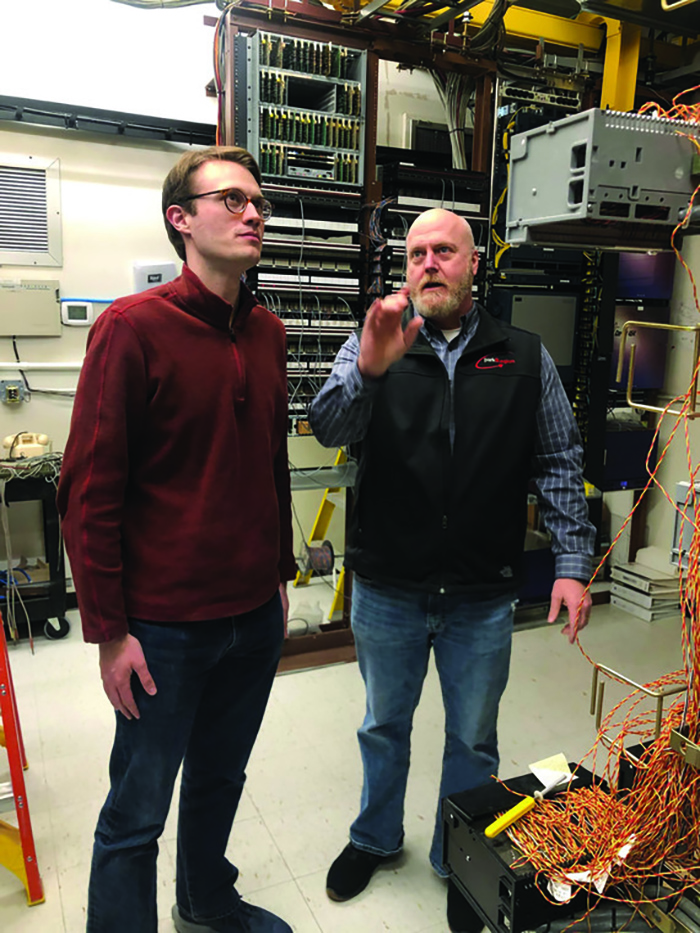OTC entities land broadband grants
News | Published on January 4, 2023 at 4:41pm GMT+0000 | Author: Tucker Henderson
0Grants to expand broadband coverage in greater Minnesota

Senator-elect Jordan Rasmusson recently toured Otter Tail Telecom/Park Region as the company looks to expand broadband coverage in the region.
A pair of Otter Tail County internet providers together have gained more than $4.5 million in grants to expand broadband coverage.
Otter Tail Telcom/Park Region is receiving nearly $3.4 million and Arvig is gaining more than $1.1 million from the Border-to-Border Broadband program administered by the Department of Employment and Economic Development’s Office of Broadband Development.
Senator-elect Jordan Rasmusson, R-Fergus Falls, has worked with state and local officials to help reach underserved areas of the region. In letters of support for local grants, Rasmusson indicated a quality fiber optic connected home has become an “essential tool for life, communications, telemedicine, school and work” and that he urged the OBD to approve the local applications due to their “economic impact importance to these rural areas.”
“Broadband access has been a focus of mine, including the line extension program that was created through legislation I successfully authored as a cost-effective approach to closing internet gaps throughout Minnesota,” Rasmusson said. “High-speed internet is crucial in today’s age of information, but we still have gaps in our system to close so area residents can enjoy equal technological footing compared with other parts of the state.”
The Otter Tail County grantees are among 61 broadband expansion projects around Minnesota set to receive a combined $99.6 million in grants. The funding primarily comes from two sources – half of a $50 million appropriation from the state Legislature and another $70 million in federal funding.
“This collaborative effort with our partners at the State of Minnesota, Otter Tail County, and local townships will be monumental for Otter Tail Telcom/Park Region to expand broadband access in Otter Tail County,” said Otter Tail Telcom/Park Region CEO Dave Bickett. “The project’s investment will bring fiber-to-the-premise infrastructure to approximately 1,186 locations in the rural Fergus Falls area. The state-of-the-art technology will offer Internet speeds of up to 1Gig/1Gig. We will be reaching out to all locations in the coming months as we prepare to implement the project. We extend our sincere appreciation to our partners for their initial and continued support as well as all the residents and businesses in the project area who will entrust us with the privilege to be their communication services provider.”
Overall, providers estimate the funding will extend new high-speed internet connections to more than 33,000 Minnesota homes and businesses in 48 counties. A list of grant awards by project can be found at www.mn.gov/deed.
DEED soon will launch a new Border-to-Border Request for Proposals to award $67.6 million for broadband deployment ($25 million from the Legislature and $42.6 million in federal funding). Applications are slated to open later this month. Check the DEED website for more information as it becomes available.
Arvig’s East Otter Tail County project
Arvig (East Otter Tail Telephone) will build a fiber optic mainline in the southeast region of Otter Tail County near Battle Lake, Henning, Parkers Prairie, and Urbank. Speeds are expected to increase throughout the area. According to the project outline, with the completion of this project, these Otter Tail County residents will be able to run their at-home businesses and farms, or work from home, more efficiently. They can continue or pursue their education online with confidence, they will have better access to telehealth services, and they will simply be able to access more entertainment and stay connected with their friends and family.
“As a service provider, it’s encouraging to be a part of this large-scale investment in rural broadband in Minnesota,” said David Arvig, Vice President, and Chief Operating Officer at Arvig. “These crucial projects will serve residents with the speeds they need to keep up with the next-generation demands of internet connectivity, whether it’s for work, entertainment or day-to-day life.”
